Another small range day remains within identified support and resistance. A consolidation was expected to continue.
Summary: Another multi week consolidation may have begun, which may end about 1,217 and may not move below 1,201.14.
Resistance is about 1,240 and support is about 1,220.
The final target for this bounce to end is at strong resistance about 1,305 – 1,310.
New updates to this analysis are in bold.
Grand SuperCycle analysis is here.
Last historic analysis with monthly charts is here.
There are four remaining weekly wave counts at this time for cycle wave b: a triangle, a flat, a combination, and a double zigzag.
At this stage, they will now be presented roughly in order of probability. The triangle and the double zigzag wave counts have about an even probability; the combination and flat wave counts now look less likely.
MAIN ELLIOTT WAVE COUNT
WEEKLY CHART – TRIANGLE
Cycle wave b may be an incomplete regular contracting triangle. Primary wave E may not move beyond the end of primary wave C above 1,365.68. Within primary wave E, intermediate wave B may not move beyond the start of intermediate wave A below 1,160.75.
Four of the five sub-waves of a triangle must be zigzags, with only one sub-wave allowed to be a multiple zigzag. Wave C is the most common sub-wave to subdivide as a multiple, and this is how primary wave C for this example fits best. Primary wave E would most likely be a single zigzag. It is also possible that it may subdivide as a triangle to create a rare nine wave triangle.
There are no problems in terms of subdivisions or rare structures for this wave count. It has an excellent fit and so far a typical look.
Primary wave E may now continue higher as a large three wave structure.
DAILY CHART – TRIANGLE
Primary wave E should now be underway for this wave count.
Primary wave E should subdivide as a zigzag. Intermediate wave (A) should subdivide as a five wave structure.
Within intermediate wave (A), so far minor waves 1 through to 3 may now be complete. Minor wave 3 exhibits no Fibonacci ratio to minor wave 1. Minor wave 2 was a relatively shallow 0.497 flat correction. Minor wave 4 may exhibit alternation as a deeper zigzag, or it may also be a more shallow sideways combination or triangle.
Minor wave 4 may not move into minor wave 1 price territory below 1,201.14.
Minor wave 2 lasted 27 sessions. Minor wave 4 may exhibit reasonable proportion to minor wave 2; it may last about a Fibonacci 21 or 34 sessions. If minor wave 4 unfolds as a zigzag, then it may be quicker, possibly lasting about a Fibonacci 13 sessions.
Draw the channel about intermediate wave (A) using Elliott’s first technique. Draw the first trend line from the ends of minor waves 1 to 3, then place a parallel copy on the end of minor wave 2. If it is time consuming enough, then minor wave 4 may find support about the lower edge of this channel.
A target for primary wave E is the strong zone of resistance about 1,305 to 1,310. Primary wave E is most likely to subdivide as a zigzag (although it may also subdivide as a triangle to create a rare nine wave triangle), and it should last at least a Fibonacci 13 weeks. It may also last a total Fibonacci 21 or 34 weeks. So far it has lasted only 8 weeks. Primary wave E may not move beyond the end of primary wave C above 1,365.68.
HOURLY CHART – TRIANGLE
Minor wave 4 may be beginning with a three wave structure, a flat correction. This flat correction may be labelled as either minute wave a or minute wave w.
If minute wave a subdivides as a three, then minor wave 4 may be unfolding as a flat or a triangle.
If minute wave w subdivides as a flat correction, then minor wave 4 may be unfolding as a double flat or double combination.
The flat correction which is labeled minute wave a or w may be a regular flat correction. Minuette wave (b) is a 0.98 length of minuette wave (a). The most common ratio for minuette wave (c) would be equality in length with minuette wave (a), which is also close to the 0.236 Fibonacci ratio.
Overall, minor wave 4 may be expected to continue for a few more weeks.
WEEKLY CHART – DOUBLE ZIGZAG
It is also possible that cycle wave b may be a double zigzag or a double combination.
The first zigzag in the double is labelled primary wave W. This has a good fit.
The double may be joined by a corrective structure in the opposite direction, a triangle labelled primary wave X. The triangle would be about three quarters complete.
Within the triangle of primary wave X, intermediate wave (C) should be complete. Within intermediate wave (D), minor wave B may not move beyond the start of minor wave A below 1,160.75.
Intermediate wave (D) would most likely subdivide as a single zigzag. The subdivisions at the daily and hourly chart level for this wave count would be the same as for the first triangle wave count above; a zigzag unfolding higher would be labelled A-B-C.
This wave count may now expect choppy overlapping movement in an ever decreasing range for several more months.
Primary wave Y would most likely be a zigzag because primary wave X would be shallow; double zigzags normally have relatively shallow X waves.
Primary wave Y may also be a flat correction if cycle wave b is a double combination, but combinations normally have deep X waves. This would be less likely.
This wave count has good proportions and no problems in terms of subdivisions.
WEEKLY CHART – COMBINATION
If cycle wave b is a combination, then the first structure in a double may be a complete zigzag labelled primary wave W.
The double may be joined by a three in the opposite direction, a zigzag labelled primary wave X.
The second structure in the double may be a flat correction labelled primary wave Y. My research on Gold so far has found that the most common two structures in a double combination are one zigzag and one flat correction. I have found only one instance where a triangle unfolded for wave Y. The most likely structure for wave Y would be a flat correction by a very wide margin, so that is what this wave count shall expect.
Within a flat correction for primary wave Y, the current downwards wave of intermediate wave (B) may be a double zigzag. Intermediate wave (B) must retrace a minimum 0.9 length of intermediate wave (A) at 1,147.34. Intermediate wave (B) may move beyond the start of intermediate wave (A) as in an expanded flat.
Because the minimum requirement for intermediate wave (B) is not yet met, this wave count requires that intermediate wave (B) continues lower. This is the most immediately bearish of all four weekly wave counts.
When intermediate wave (B) is complete, then intermediate wave (C) would be expected to make at least a slight new high above the end of intermediate wave (A) at 1,365.68 to avoid a truncation. Primary wave Y would be most likely to end about the same level as primary wave W at 1,374.91, so that the whole structure takes up time and moves price sideways, as that is the purpose of double combinations.
While double combinations are very common, triples are extremely rare. I have found no examples of triple combinations for Gold at daily chart time frames or higher back to 1976. When the second structure in a double is complete, then it is extremely likely (almost certain) that the whole correction is over.
DAILY CHART – COMBINATION
Intermediate wave (B) may be unfolding lower as a double zigzag.
The first zigzag may be complete, labeled minor wave W. The double may now be joined a complete three in the opposite direction, a zigzag labelled minor wave X. X waves within double zigzags are usually fairly shallow and often also reasonably brief.
For this wave count, minor wave Y downwards should now continue.
HOURLY CHART – COMBINATION
If minor wave X is complete, then minor wave Y should begin with a five down on the hourly chart; this would be incomplete.
Minor wave Y should subdivide as a zigzag, and within it minute wave a must subdivide as a five, most likely an impulse. Within the impulse, minuette waves (i) and (ii) may now be complete. Minuette wave (iii) may have begun.
Within minuette wave (iii), subminuette wave i may be complete. Subminuette wave ii may not move beyond the start of subminuette wave i above 1,238.72.
WEEKLY CHART – FLAT
It is possible that cycle wave b may be a flat correction. Within a flat correction, primary wave B must retrace a minimum 0.9 length of primary wave A at 1,079.13 or below. Primary wave B may make a new low below the start of primary wave A at 1,046.27 as in an expanded flat correction.
Only a new low reasonably below 1,123.08 would provide reasonable confidence in this wave count.
Intermediate wave (C) must subdivide as a five wave structure; it may be unfolding as an impulse. Within intermediate wave (C), minor waves 1 through to 4 may be complete. If it continues further, then minor wave 4 may not move into minor wave 1 price territory above 1,307.09.
The blue channel is drawn using Elliott’s second technique. Minor wave 5 may end at support about the lower edge of this channel.
Minor wave 2 was a double zigzag lasting nine weeks. Minor wave 4 exhibits little alternation as a single zigzag and reasonable proportion lasting ten weeks.
TECHNICAL ANALYSIS
WEEKLY CHART
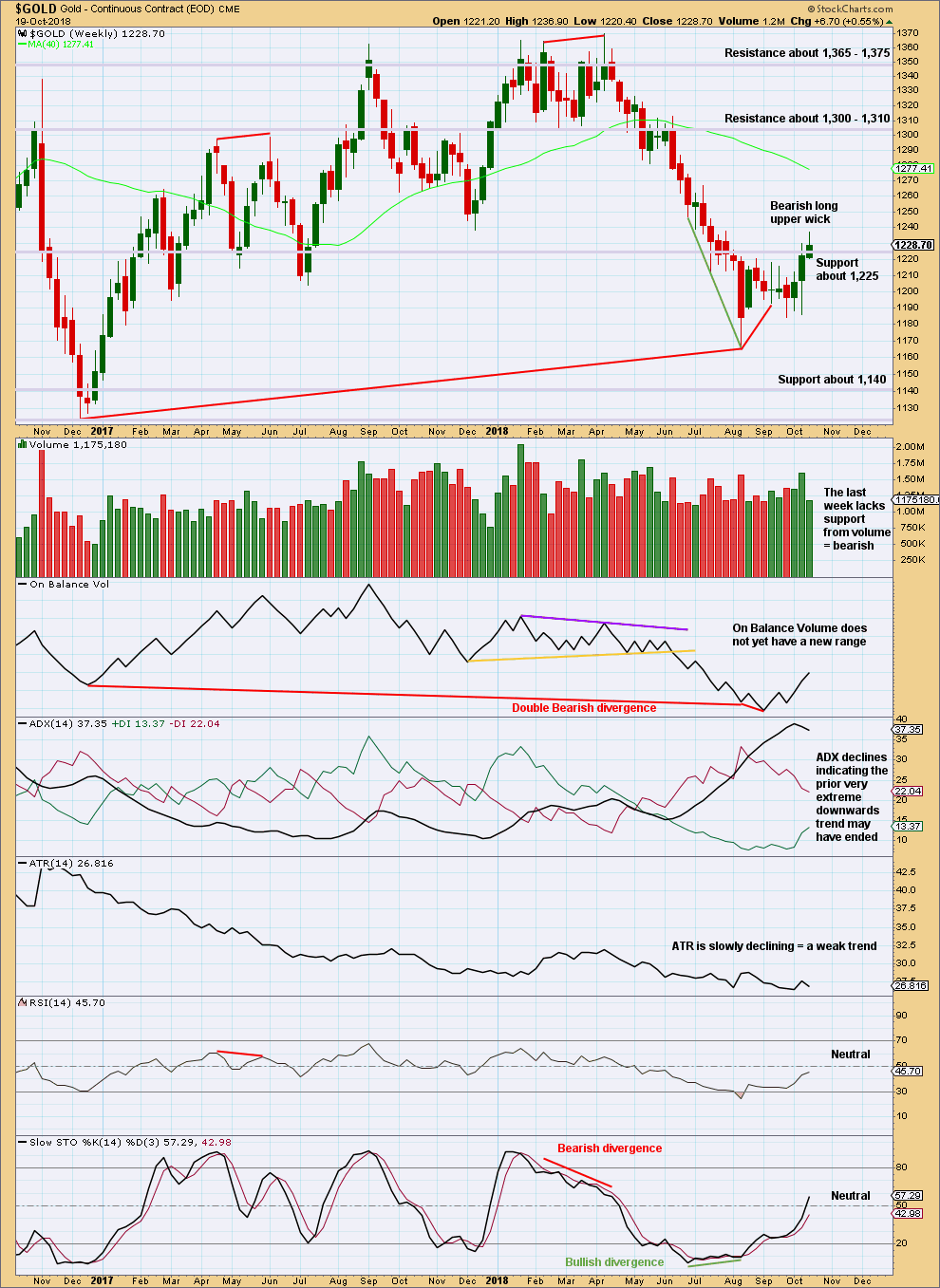
Click chart to enlarge. Chart courtesy of StockCharts.com.
On Balance Volume is lower than its prior point at the end of November 2015. This divergence is extremely bearish but does not rule out a consolidation unfolding here; the divergence does strongly support the Triangle wave count, which expects a consolidation or bounce up to test resistance now and then a continuation of a major bear market. It could also support the flat wave count that allows for a new low below 1,046.27 in coming months.
The short term volume profile and the long upper candlestick are bearish this week. Some downwards or sideways movement this week looks most likely.
DAILY CHART
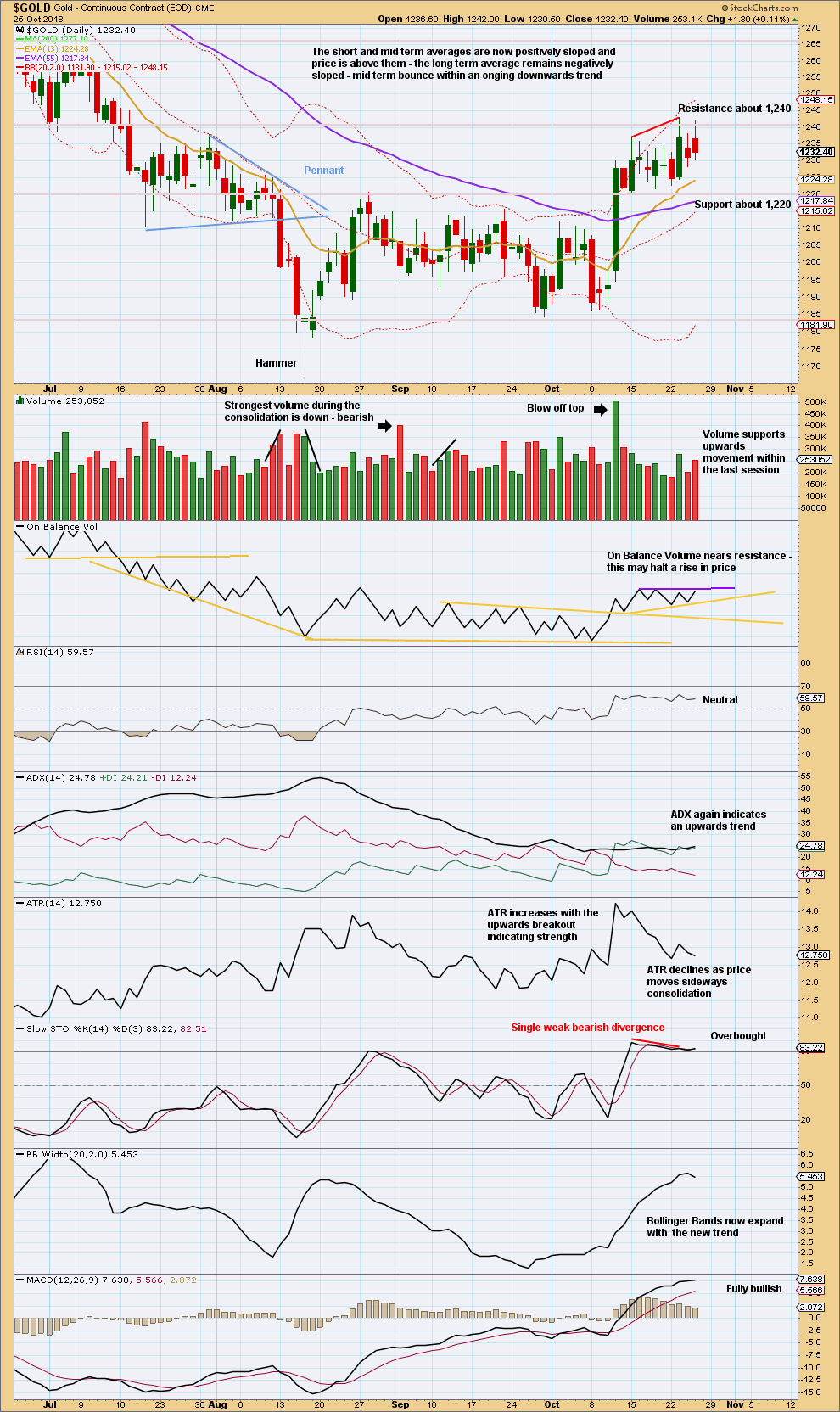
Click chart to enlarge. Chart courtesy of StockCharts.com.
Price remains range bound with resistance about 1,240 and support about 1,220. While ADX still indicates an upwards trend, the ADX line is now just above the directional lines indicating the trend is becoming extreme.
Some further consolidation may be expected here. When the consolidation may be approaching maturity, then volume analysis may indicate the most likely breakout direction.
On Balance Volume is tracing out a new range.
GDX WEEKLY CHART
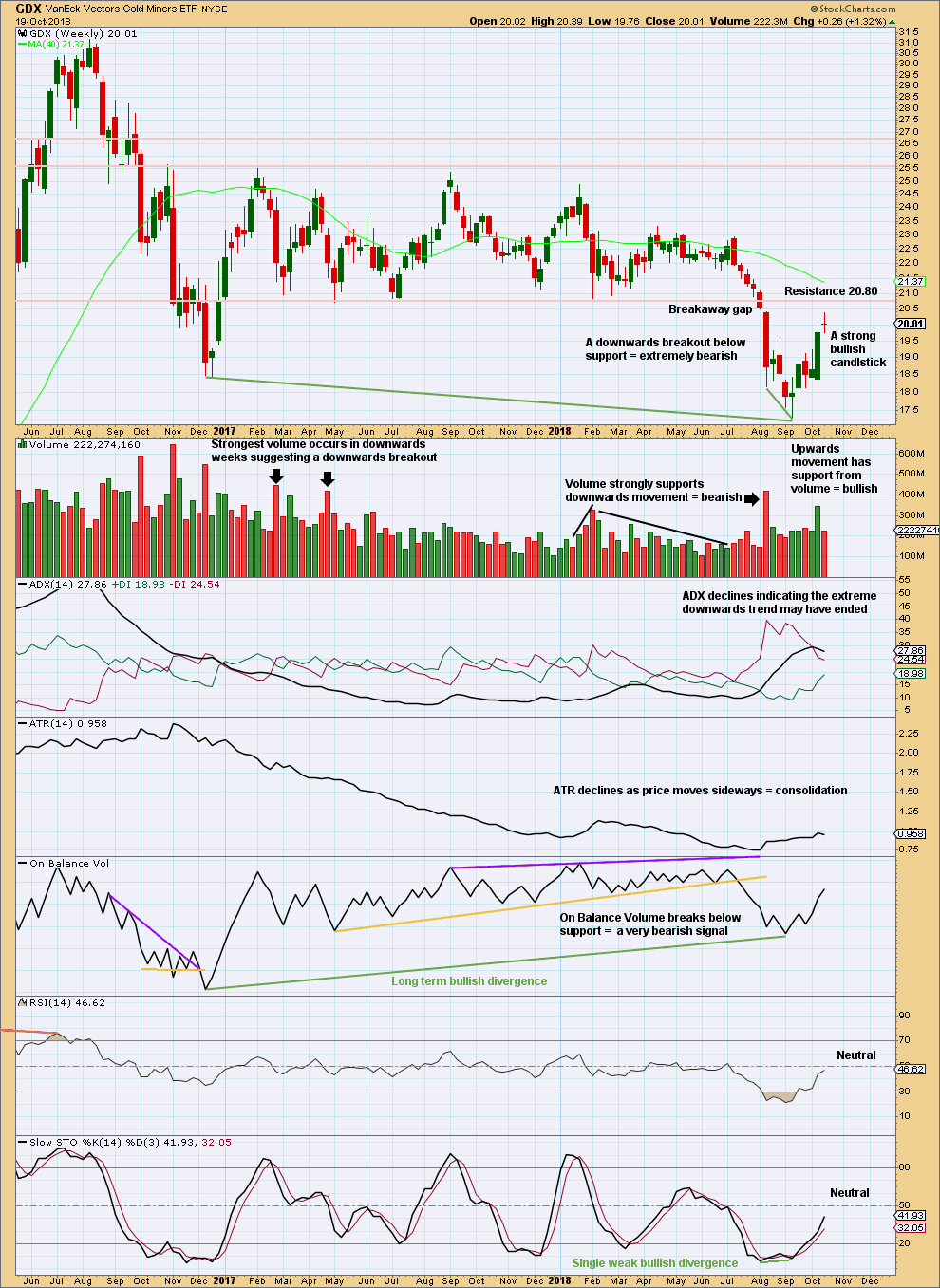
Click chart to enlarge. Chart courtesy of StockCharts.com.
GDX had a large consolidation that lasted from January 2017 to August 2018. A downwards breakout below support at 20.80 in early August 2018 is highly significant. The breakout had support from volume, which adds confidence.
Upwards movement of the last five weeks would most likely be a bounce to backtest resistance at 20.80. If price does reach up to this point, then the probability of a quick turn there and a strong downwards trend is highly likely.
A technical principle is the longer price consolidates, the longer and stronger the resulting trend may be. The downwards trend developing here may last over a year.
A target for the eventual low is about 16.02.
The doji last week puts the short term upwards bounce from bullish to neutral.
GDX DAILY CHART
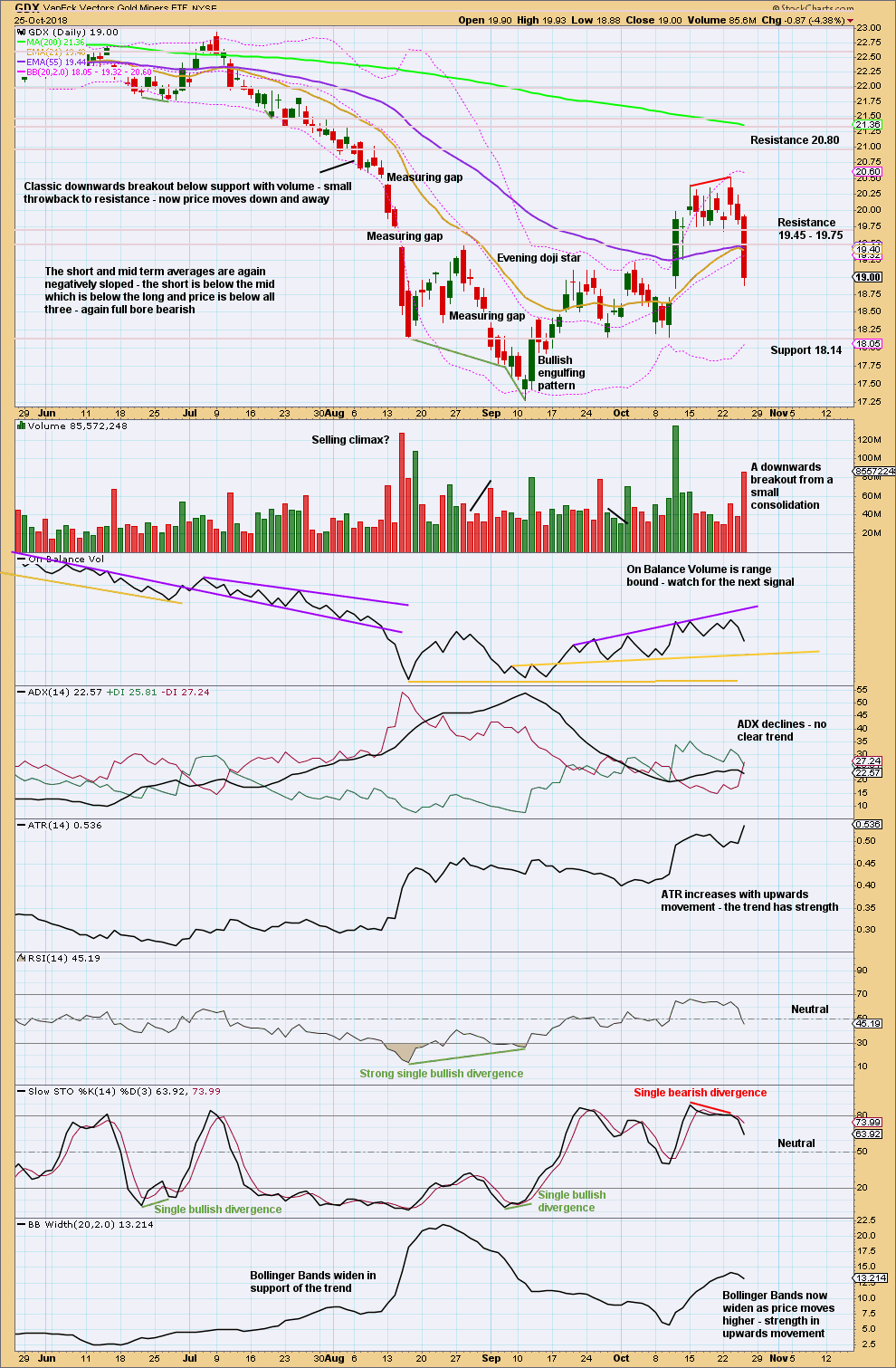
Click chart to enlarge. Chart courtesy of StockCharts.com.
It now looks like GDX may be curving back up to test very strong resistance about 20.80. If it does get up to this point, then that may offer a very good entry point for a short position which may be held for a reasonably long term.
GDX has broken down from a small consolidation. Look for next support about 18.14.
Published @ 09:03 p.m. EST.
—
Careful risk management protects your trading account(s).
Follow my two Golden Rules:
1. Always trade with stops.
2. Risk only 1-5% of equity on any one trade.

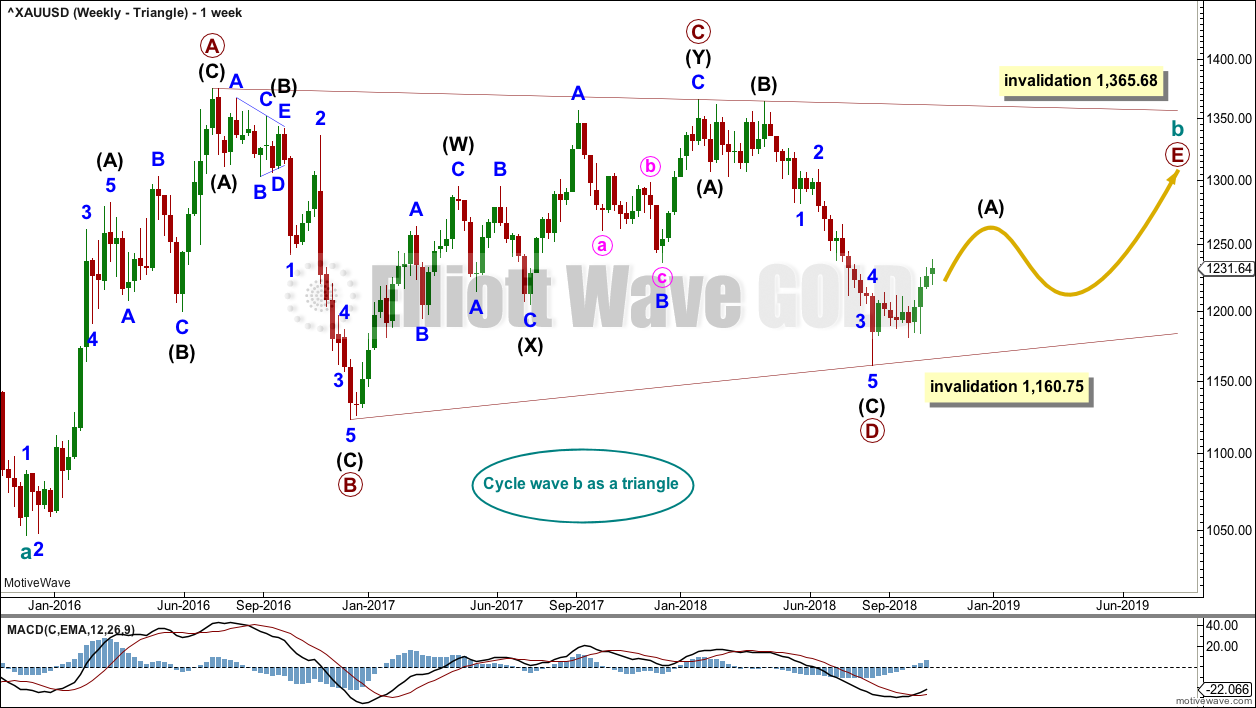
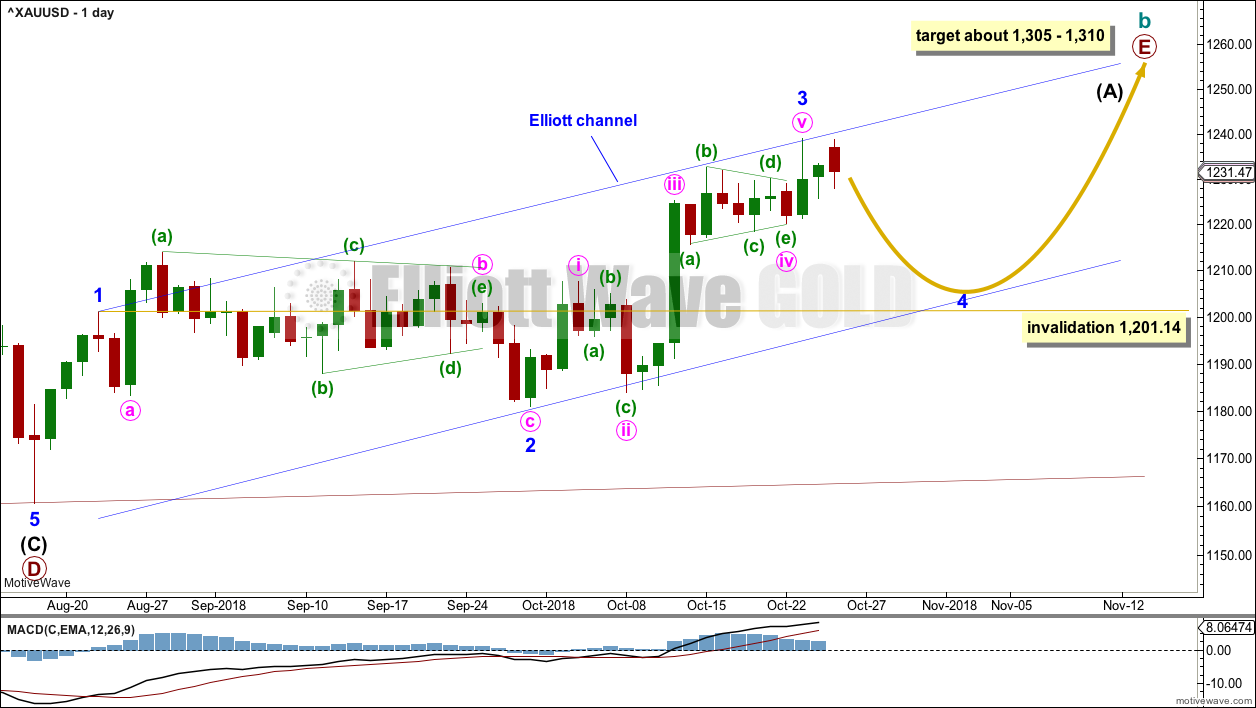
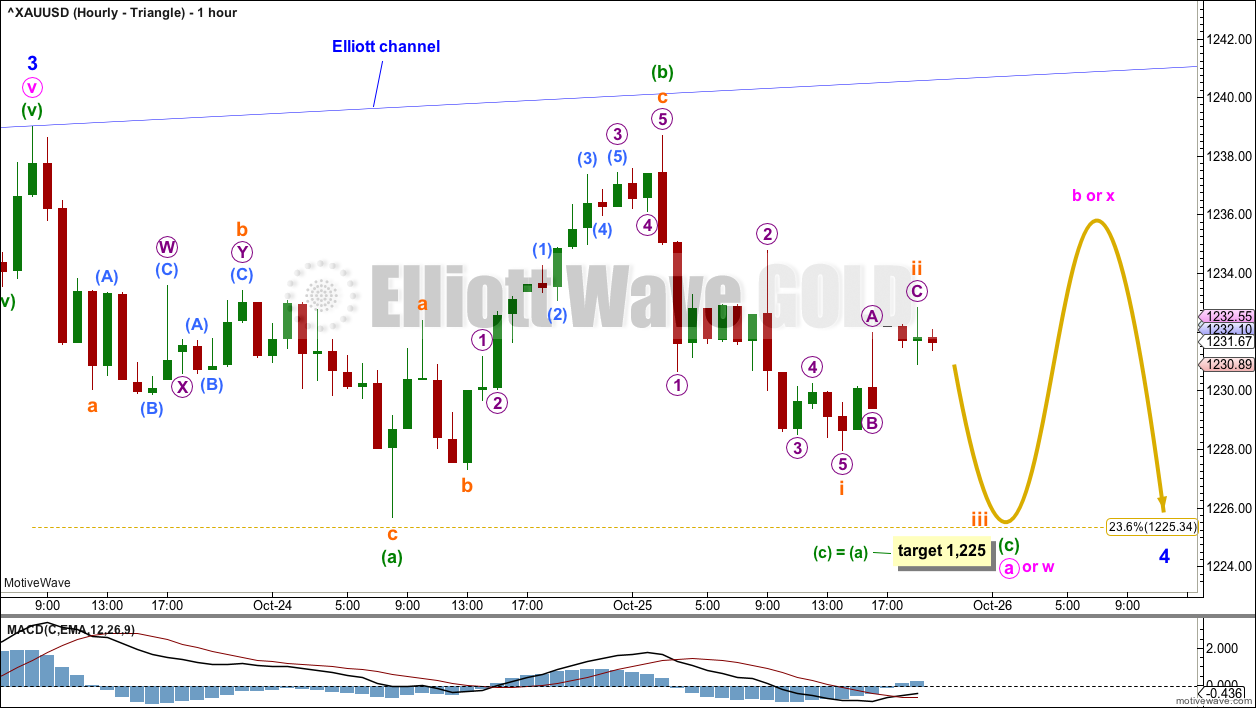
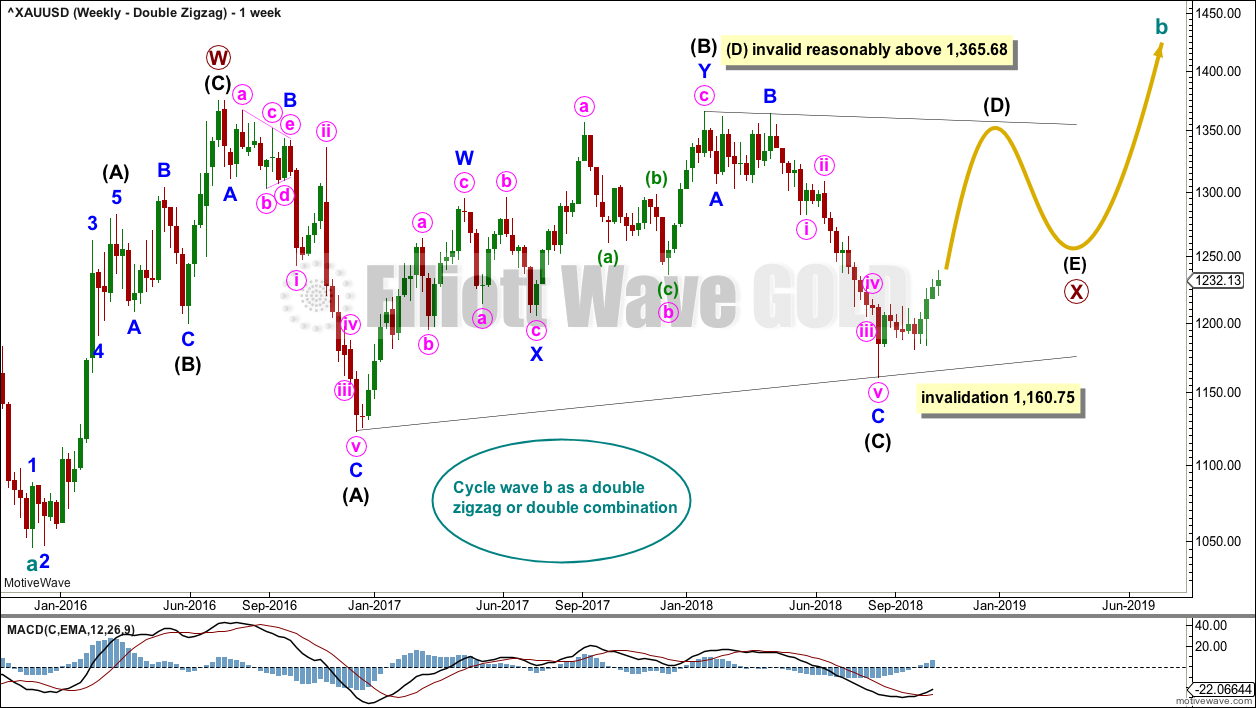
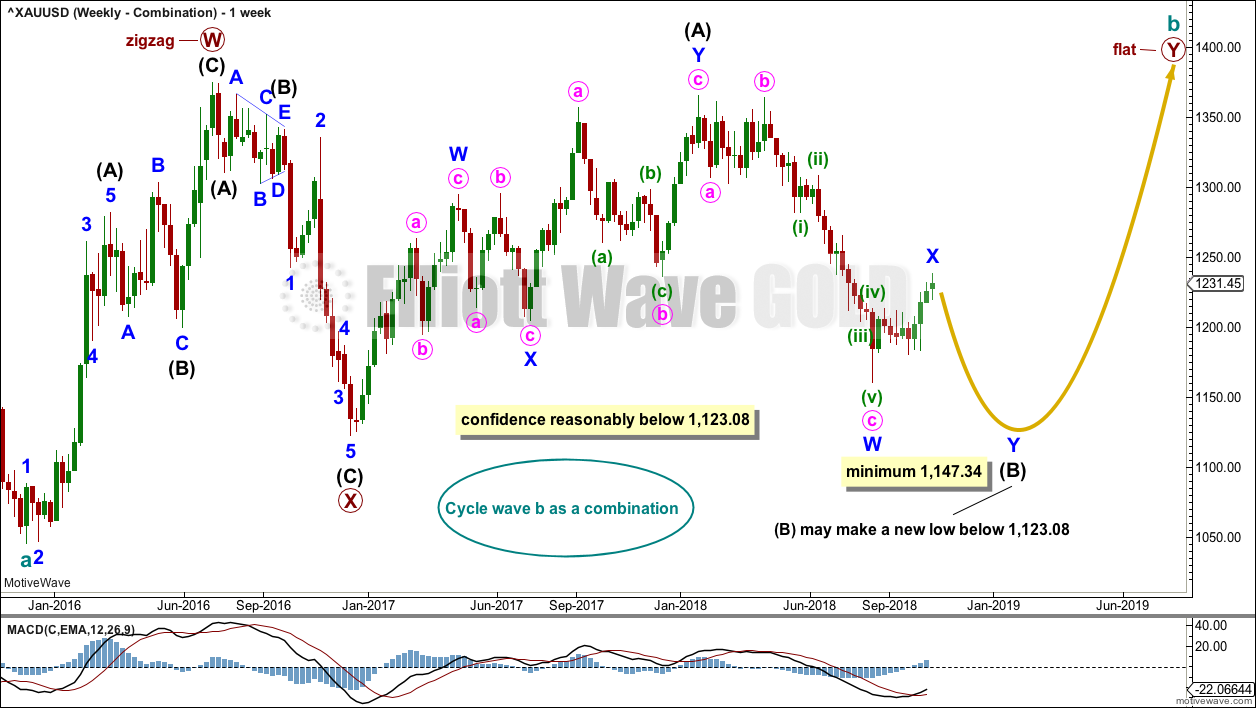
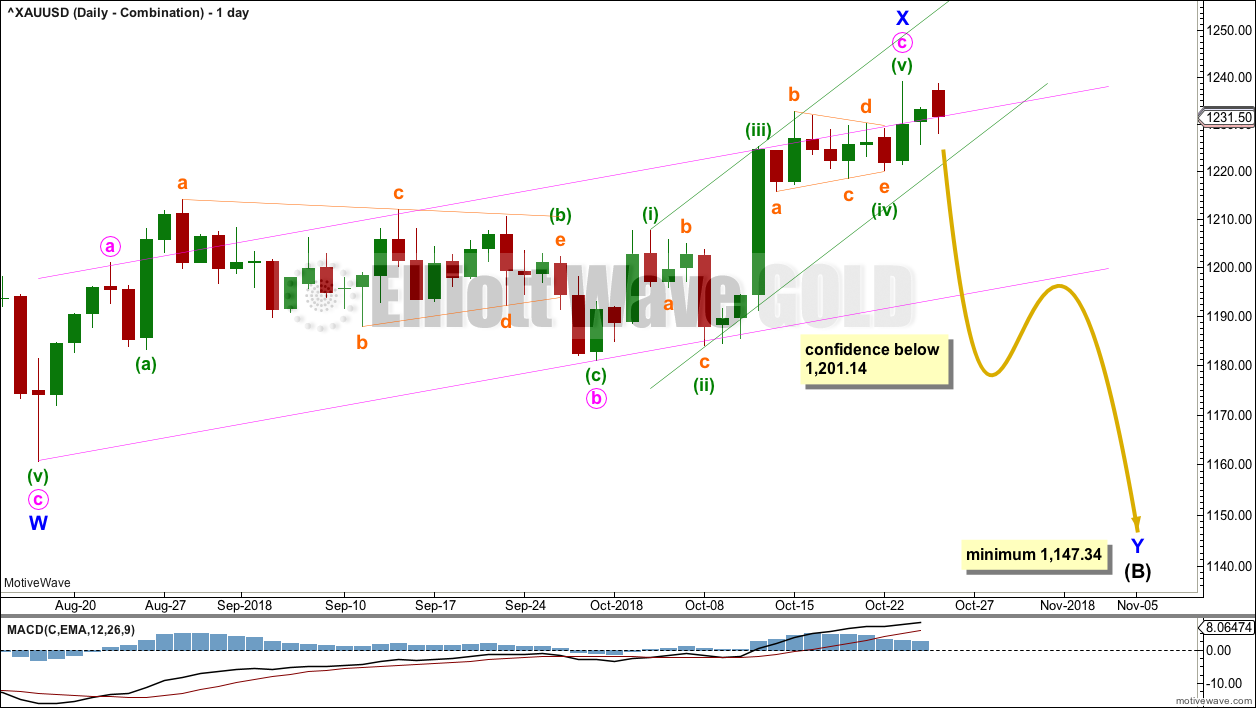
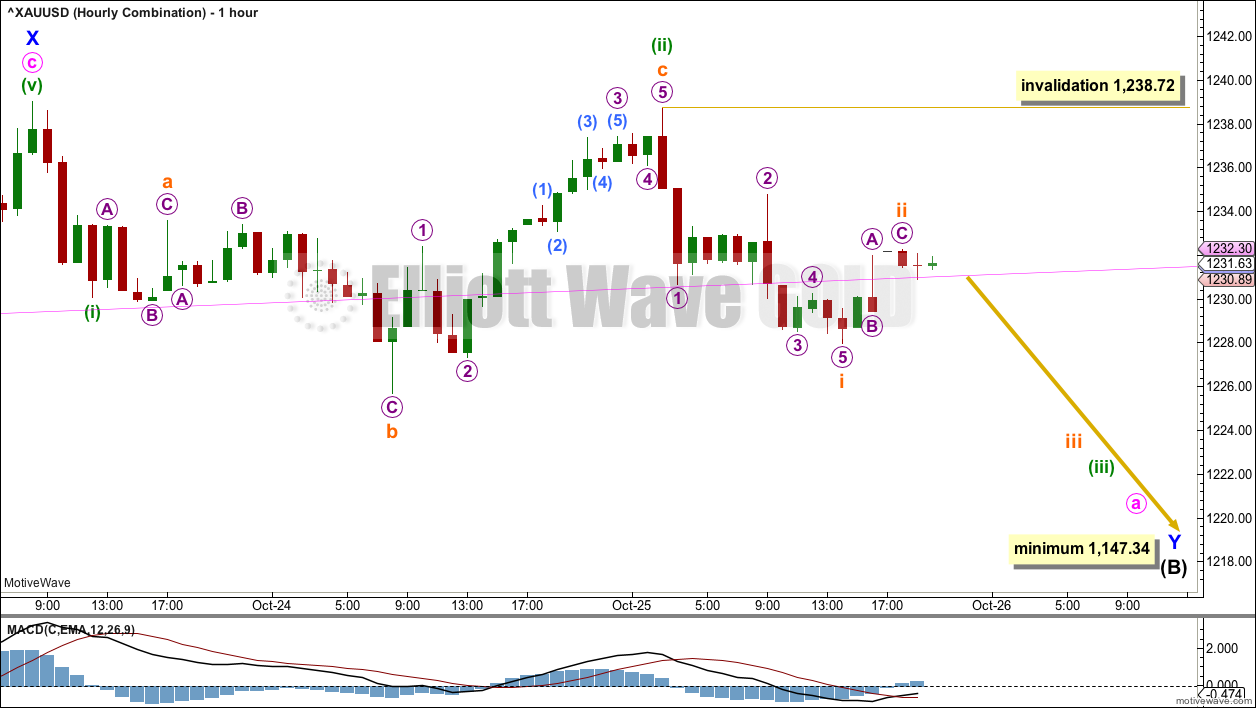
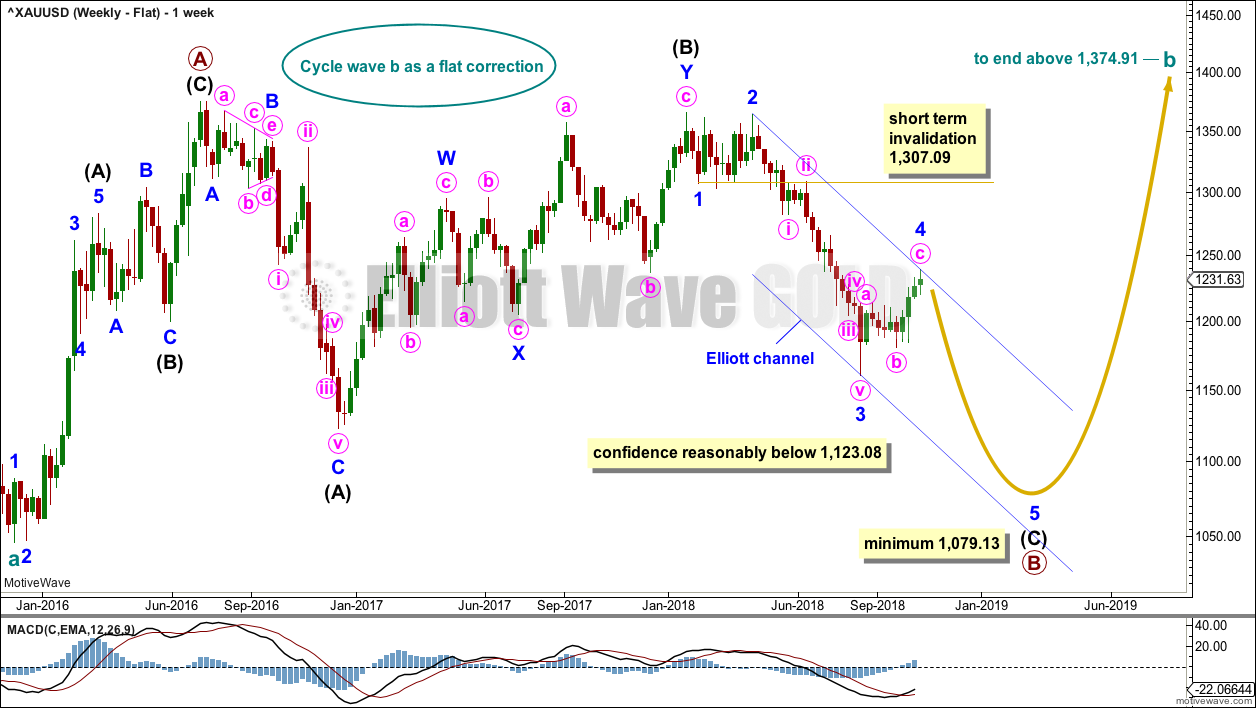
Hourly chart updated:
Notice the very nice Evening Doji Star pattern on the hourly chart at today’s high.
An expanded flat may be unfolding. I’m going to still label this minute wave a or w.
The most common Fibonacci ratio for minute c is used to calculate a target.
what about a triangle for Minor 4?
It doesn’t work now because what would be minute d is now too far above what would be minute b.
Within a contracting triangle minute d may not move above minute b.
Within a barrier triangle minute d should end about the same level as minute b, so that the b-d trend line looks essentially flat. It would now have a clearly positive slope.
I won’t consider an expanding triangle because I have only ever seen one before in now 11 years of analysis. The rarity means the probability is exceptionally low. And I’ve never seen on on Gold.
But what it could be now is an expanded flat, their B waves do move beyond the start of their A waves and they’re pretty common structures.
Bad earnings in Goldcorp and Newmont helped to accelerate the move down in miners…
https://www.fool.com/investing/2018/10/25/why-goldcorp-incs-stock-is-getting-pummeled-today.aspx
Break below 2016 low… ouch 🤒